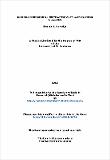Files in this item
Glacio-limnological interactions at lake-calving glaciers
Item metadata
| dc.contributor.advisor | Warren, Charles | |
| dc.contributor.author | Haresign, Eleanor C. | |
| dc.coverage.spatial | 290 | en_US |
| dc.date.accessioned | 2012-06-15T15:02:00Z | |
| dc.date.available | 2012-06-15T15:02:00Z | |
| dc.date.issued | 2004 | |
| dc.identifier.uri | https://hdl.handle.net/10023/2793 | |
| dc.description.abstract | Iceberg calving is an efficient ablation process which introduces mechanical instability to glacier systems and can cause non-linear climatic response. This thesis uses glaciological and limnological data to examine the relative contributions of calving and melting to mass loss at glacier termini, and the interplay between glaciological and limnological processes. Calving dynamics are investigated at two lake-terminating glaciers; Glaciar Leon in Chile and Fjallsjokull in Iceland. Glaciar Leon, a temperate, grounded outlet of the North Patagonian Icefield, terminates at an active but stable calving margin in Lago Leones. The calving rate of 880 m a-1 in a mean water depth of 65 m is high for lake-calving glaciers. Detailed survey of the physical limnology of Lago Leones, important for considering heat transfer to the subaqueous ice face, revealed thermocline development towards the terminus between spring and summer. Melting at the waterline along the glacier terminus facilitates calving by undercutting the subaerial calving cliff, and accounts for around a quarter of mass loss at the terminus. Waterline melting is also an important rate-controlling process for calving at Fjallsjokull. Precise quantification of melt rates (subaerial, waterline and subaqueous) at the termini of calving glaciers is difficult and hazardous, but this study has demonstrated the value of two techniques: (1) detailed survey of melt notch growth, and (2) use of a radiocontrolled boat to record water temperatures at the ice-water interface. Continuous automated monitoring showed that lake-level fluctuations are integral to calving behaviour, influencing calving event timing and size over diurnal and hourly timescales. Fjallsjokull is sensitive to climatic forcing whereas Glaciar Leon, which exhibits larger seasonal than annual fluctuations, is less sensitive. Additional controls on calving at both sites are (1) buoyancy, (2) longitudinal stretching, and (3) the force balance at the ice-water interface. Calving operates along a continuum defined by the relative importance of interacting calving mechanisms, to which the climatic response of calving glaciers is sensitive. | en_US |
| dc.language.iso | en | en_US |
| dc.publisher | University of St Andrews | |
| dc.rights | Creative Commons Attribution-NonCommercial-NoDerivs 3.0 Unported | |
| dc.rights.uri | http://creativecommons.org/licenses/by-nc-nd/3.0/ | |
| dc.subject.lcc | GB2405.H28 | |
| dc.subject.lcsh | Glaciers | en_US |
| dc.subject.lcsh | Icebergs | en_US |
| dc.subject.lcsh | Limnology | en_US |
| dc.subject.lcsh | Mass budget (Geophysics) | en_US |
| dc.title | Glacio-limnological interactions at lake-calving glaciers | en_US |
| dc.type | Thesis | en_US |
| dc.type.qualificationlevel | Doctoral | en_US |
| dc.type.qualificationname | PhD Doctor of Philosophy | en_US |
| dc.publisher.institution | The University of St Andrews | en_US |
This item appears in the following Collection(s)
Except where otherwise noted within the work, this item's licence for re-use is described as Creative Commons Attribution-NonCommercial-NoDerivs 3.0 Unported
Items in the St Andrews Research Repository are protected by copyright, with all rights reserved, unless otherwise indicated.


